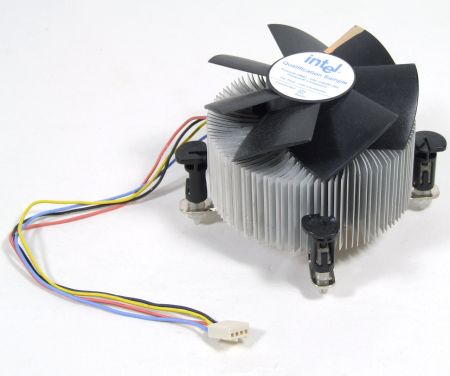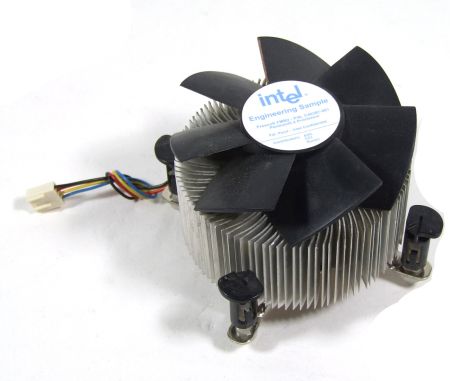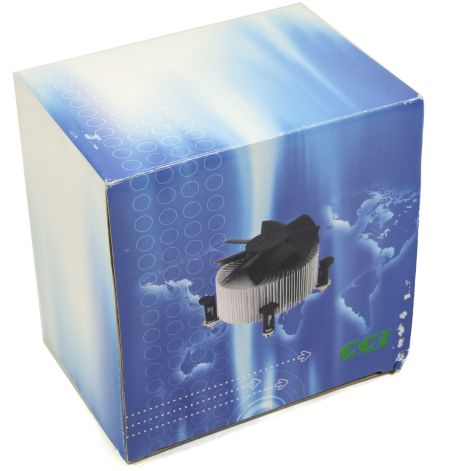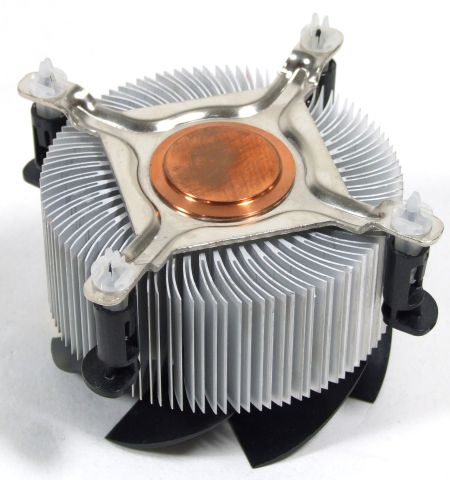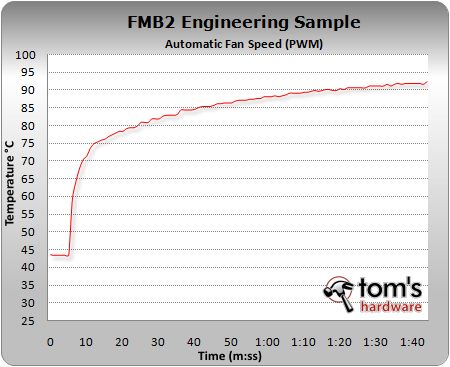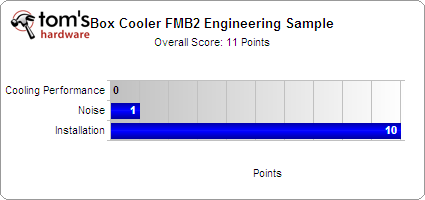CPU Cooler Charts 2008, Part 3 - Are Box Coolers any Good?
Prescott FMB2 C40387 - The Prescott's First Cooler
When Intel introduced the Socket 775 platform, the processors of the day were still using the 90 nm Prescott core. Prescott was known as one of the most power-hungry cores Intel has ever designed, dissipating a great deal more heat than its predecessors built around the 130 nm Northwood core. The new socket also required a new box cooler, which Intel presented with the model reviewed here. Its name, "Prescott FMB2", already indicates that this model was developed specifically for the new processor core.
FMB-2 Qualification Sample
This "grandfather" of all 775 box coolers had a tremendous impact on all box cooler models that followed. Its basic design, using a fan blowing air onto a cooler with arched cooling fins from above, was kept throughout subsequent generations - indeed, only details were changed when a new model was released. In some cases, the size and direction of the cooling fins was changed, the fins were bifurcated, the base of the cooler's copper core was made a little larger, or the fan speed was adjusted to better suit the CPU.
FMB-2 Engineering Sample
Among our editors, the FMB2 samples proved hard to forget, simply for their very high noise level, especially compared to the previous Socket 478 versions. Running at over 46 dB(A), this cooler easily topped almost all coolers we had tested before. Sadly, this did not translate into equally impressive cooling performance. At 93°C, the quad-core test CPU was extremely close to its thermal throttling threshold, making this cooler a poor choice for today's generation of multi-core CPUs.
The retail box of the FMB-2
The contact surface of the FMB-2
Get Tom's Hardware's best news and in-depth reviews, straight to your inbox.
| Technical Data | ||
|---|---|---|
| CPU | 100% load | idle |
| Temperature PWM | 93°C | 43.5°C |
| Noise | 46.6 dB(A) | 43.9 dB(A) |
| Fan speed | 2500 RPM | 1600 RPM |
| Weight | 494 grams | Row 4 - Cell 2 |
| Intel socket | 775 | Row 5 - Cell 2 |
Current page: Prescott FMB2 C40387 - The Prescott's First Cooler
Prev Page Comparing Box Coolers Next Page Performance FMB2 RCFH-4 - Loudest. Cooler. Ever-
Hugger I have read the 3 part article on cpu coolers a few times.Reply
In each part, the author shows the names of all the coolers that are included in the tests.
Xigmatech is one of those names.
However, I can't find test results for that cooler.
I'm ordering parts and have read good things about the Xigmatech but wanted to read the review here too.
Am I missing it or has it been left out?
Thanks.
Hugger -
bbies1973 In other forums I have seen the dispute about the best air cooler being between three models that were not tested in here. Dissapointing because two of the manufacturer's submitted coolers for this test. The three are:Reply
Zalman 9700 (8700 was tested here)
ThermalTake CL-P0401 V1 (Thermaltake was listed but I didn't see any of their products in the article)
Third, Tuniq Tower 120. (Tuniq is a subsidiary of Sunbeam, and neither are listed as represented companies for the test.
I would love to see a part 4 coming with these three pieces represented. -
Sigh. I looked at this list and then looked at the lists on frostytech, and none of the products coincide... how convenient.Reply
-
ripusheet01 how a fanless cpu cooler be noisy? how can be sound of a fanless heatsink be measured?Reply -
dragunover This article is Bull,it doesn't list the common coolers,and he obviously used crap thermal grease.Arctic Silver 5 and a Xigmatek/Scythe/Tuniq anyone?Reply -
gto127 It's strange that thermalright isn't mentioned here. They've been consistantly at the top of the cooling game for years and are included in most site cool off tests and come up on top quite frequently. Please include in future tests.Reply -
Twist86 Seems like none of the best coolers are mentioned here. Just ones that are over priced/out performed by cheaper coolers.Reply
Zalman 9700
Xigmatek S1283
Tuniq Tower 120
This review fails.
